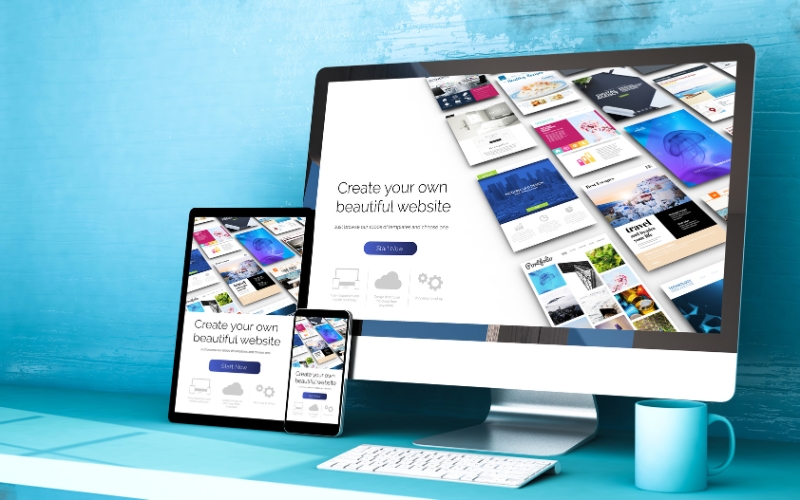
When it comes to niche industry website design, the first step in creating an effective site is understanding the unique characteristics and needs of your target audience. A well-designed website should not only look great but also cater specifically to the demands and expectations of your industry’s visitors. This deep understanding guides the layout, content, and functionality of the website, ensuring it resonates with users and fulfills both their needs and the industry standards. In this article, we will explore how understanding your niche is the key to designing a targeted website that drives success.
Understanding Your Niche: The First Step to a Targeted Website Design

Before diving into the creation of a niche industry website design, it’s crucial to take a step back and understand the core needs, preferences, and challenges of the industry you’re targeting. Researching and grasping these elements will directly inform your design choices, ultimately creating a more effective website that resonates with your audience.
Every niche industry comes with its own set of unique characteristics, such as the specific problems faced by customers, the type of content they seek, and how they engage with websites. Whether you’re building a website for a law firm, a tech startup, or a health and wellness brand, a deep understanding of the audience and their expectations will guide your website’s layout, features, and content strategy. This foundational research ensures that the website serves both user needs and industry standards, leading to a more intuitive, personalized, and engaging experience.
When considering niche industry website design, the first step is to research who your target audience is. For example, if your website serves a highly specialized tech industry, your design should incorporate modern, cutting-edge aesthetics, detailed technical content, and a streamlined user journey. Conversely, for a niche in wellness or lifestyle, soft colors, calming visuals, and engaging storytelling may be more appropriate. Knowing your audience allows you to make design decisions that are in line with their expectations, creating an emotional connection with the user and enhancing the chances of conversion.
Beyond design aesthetics, understanding your niche’s challenges and requirements will impact the functionality of your website. For example, if your niche requires online booking or e-commerce functionality, your website needs to prioritize these features in its design. If you are in a technical field, consider integrating advanced features like search functionalities, live chat support, or industry-specific tools that elevate the user experience. These strategic design choices, rooted in niche research, ultimately enhance usability and satisfaction.
Content is another key area that is informed by your understanding of the niche. A niche industry website design that works well for one sector may not work for another. The tone, messaging, and type of content you showcase should be crafted with your target audience in mind. Whether it’s industry-specific blogs, case studies, or visual portfolios, the content should speak directly to the problems, interests, and aspirations of your audience.
Tailoring Your Website’s Aesthetic to Match Industry Expectations

When designing a niche industry website design, one of the most critical aspects to consider is the aesthetic. A website’s design should not only reflect the brand’s identity but also align with the expectations of its specific industry and audience. A well-crafted aesthetic creates an immediate connection with visitors and sets the tone for their entire user experience, ultimately guiding them toward taking action—whether that’s making a purchase, signing up, or simply engaging with the content.
For niche industry website design, every detail, from color scheme to typography, plays a significant role in communicating the right message. For example, if you are designing a website for a tech company, the aesthetic should reflect innovation and modernity. A sleek, minimalist design with sharp lines, bold fonts, and a color palette that incorporates cool tones like blues and blacks might be most appropriate. Such a design speaks to an audience that expects cutting-edge solutions and easy-to-use interfaces. Incorporating interactive elements such as animated transitions or dynamic backgrounds can further reinforce the modern, forward-thinking image of a tech company.
On the other hand, a niche industry website design for a health and wellness brand calls for a completely different aesthetic approach. Here, the design should evoke feelings of calm, comfort, and trust. Soft pastel colors like light blues, greens, or even lavender help create a soothing atmosphere, which is essential for brands in this space. The use of organic shapes, flowing lines, and imagery of nature or peaceful settings can also reinforce this peaceful vibe. The goal is to align the website design with the brand’s promise of promoting well-being, which builds trust with the audience and encourages engagement.
Moreover, the design should reflect the values and goals of the business, as well as the practical needs of the users. For a niche industry website design, especially in specialized fields like finance or law, the aesthetic may need to be more professional, authoritative, and clean. A balance of professional colors, refined fonts, and structured layouts conveys competence and reliability. Conversely, a creative industry might benefit from a more artistic design, using vibrant colors, unique layouts, and bold visuals that speak to the brand’s creativity.
User-Centric Design: Prioritizing Navigation and User Experience

In the world of niche industry website design, creating a user-centric website is paramount. A website’s success is often determined by how easy and enjoyable it is for users to navigate. By prioritizing user experience (UX) and intuitive design, businesses can ensure that visitors not only find what they’re looking for but also enjoy the process of getting there. This translates into higher engagement, longer visit durations, and increased conversion rates.
A crucial element of user-centric design in niche industry website design is easy navigation. Clear, logical navigation ensures that users can find information quickly without feeling frustrated or overwhelmed. For niche industries, this can be particularly important, as visitors often come with specific needs or expectations. Creating a website with well-organized menus, simple categories, and easily accessible content helps guide users toward their goals, whether it’s making a purchase, scheduling a consultation, or learning more about a service.
To enhance usability, the website’s structure should be straightforward, with each page flowing naturally to the next. For example, when designing a niche industry website design for a professional service like law or consulting, including clear headings, subheadings, and call-to-action (CTA) buttons will allow users to know exactly where they are on the site and what actions they can take next. CTAs, such as “Contact Us,” “Get a Quote,” or “Learn More,” should be strategically placed throughout the site to encourage user interaction. These buttons should be bold and easily visible, giving visitors clear directions without feeling overwhelmed.
Fast load times are another essential component of user experience in niche industry website design. A slow-loading website can drive users away, especially when they are looking for quick answers or services. For niche industries, where clients may already be in need of specific solutions, delays can result in lost opportunities. Optimizing images, compressing files, and leveraging modern web technologies can help ensure that the site loads quickly, no matter the device or connection speed.
In short, focusing on user-centric design for a niche industry website design is all about simplifying the user journey. By prioritizing easy navigation, clear CTAs, and fast loading times, businesses can provide a seamless experience that helps users find the information they need without frustration. When executed correctly, user-centric design doesn’t just improve the usability of the site—it enhances the overall user experience, fostering trust, engagement, and conversions.
Responsive Design: Ensuring Compatibility Across Devices

In today’s digital landscape, a niche industry website design must be responsive to meet the demands of an increasingly mobile-first world. As users access websites from a wide variety of devices—smartphones, tablets, and desktops—it is essential that websites adapt seamlessly to provide the best possible user experience across all screen sizes. A responsive design ensures that your website looks great and functions flawlessly, whether on a large desktop monitor or a small mobile device.
The need for responsive design in niche industry website design cannot be overstated. When designing a website for a specific industry, it is important to cater to the unique needs of the audience, which may be using different devices at different times. For instance, professionals in industries like real estate, health, or e-commerce may access your website on-the-go, requiring fast load times and easy navigation on mobile devices. A responsive design ensures that these visitors don’t encounter frustrating issues, such as misaligned content, slow load times, or hard-to-read text, which can result in high bounce rates and lost opportunities.
A properly executed niche industry website design should include flexible grid layouts that adjust based on screen size, ensuring content is appropriately scaled for smaller screens. Images and videos should also resize to avoid distortion, providing a clean, visually appealing experience no matter the device. Text should remain readable, buttons should be clickable, and navigation should be intuitive—elements like these are crucial for improving user engagement and encouraging conversions.
Moreover, responsive design not only enhances the user experience but also significantly benefits search engine optimization (SEO). Google, for instance, prioritizes mobile-friendly websites in its rankings, as mobile-first indexing is now the default. A niche industry website design that adapts well to mobile devices can improve your website’s visibility in search engine results, ultimately driving more organic traffic. Having a mobile-optimized site also ensures that users can easily interact with your content, whether they’re researching services or making a purchase.
SEO Optimization for Niche Websites: Balancing Design and Searchability

When it comes to niche industry website design, optimizing the site for search engines is just as important as creating a visually appealing design. A beautifully crafted website can be rendered useless if it doesn’t rank well on search engine results pages (SERPs). Ensuring a balance between design aesthetics and technical SEO is key to making sure the site is both user-friendly and discoverable.
One of the most fundamental aspects of niche industry website design is the integration of SEO-friendly elements. These elements help search engines understand and index the content properly, improving visibility and increasing traffic. One of the first steps in this process is optimizing the meta tags, including meta titles and descriptions. These tags play a significant role in how search engines understand the content of the page and are often the first thing users see on SERPs. For a niche industry website design, it is essential to include target keywords naturally within the meta title and description. These should be compelling and aligned with the search intent of your audience.
Alt text for images is another SEO component that should not be overlooked in niche industry website design. Images are an integral part of website design, providing visual appeal and enhancing the user experience. However, search engines cannot “see” images the way humans do, which is where alt text comes in. By writing descriptive, keyword-rich alt text for images, you ensure that your website is accessible to search engines and users with visual impairments. Moreover, well-optimized images can appear in image search results, driving additional traffic to your site.
Another critical factor in niche industry website design is ensuring fast load times. A slow-loading website can harm both user experience and SEO rankings. Search engines, particularly Google, prioritize websites that load quickly, and a slow site can result in higher bounce rates, meaning visitors leave before engaging with your content. To optimize speed, ensure that images are compressed, files are minimized, and caching strategies are implemented effectively. Fast load times are essential for keeping visitors engaged and improving your website’s ranking.
Lastly, implementing schema markup in your niche industry website design helps search engines understand the context of your content. Schema markup is a type of structured data that provides additional information about your website to search engines. This can improve visibility in rich snippets, like reviews or FAQs, which stand out on SERPs and can increase click-through rates.
Conclusion:
When designing an effective niche industry website design, it’s essential to stay informed about the latest design trends and best practices. For more detailed insights on how to enhance user experience and boost your website’s performance, check out this comprehensive guide from Smashing Magazine, which covers everything from user-centric design to responsive strategies. This resource provides in-depth expertise to ensure your website aligns with industry standards and meets your audience’s needs.
In conclusion, niche industry website design starts with an in-depth understanding of your audience and the specific needs of your industry. By researching your target market, designing with intent, and prioritizing user experience, you can craft a website that stands out in your niche. Whether it’s through tailored aesthetics, user-centric features, or optimized content, the key to success lies in ensuring that every element of your website speaks directly to the audience you’re trying to engage. With a thoughtful and targeted approach, your website will not only attract traffic but also foster lasting relationships with visitors.
For more details or to discuss your specific Website Development and Design, visit our Website Development and Design page.

